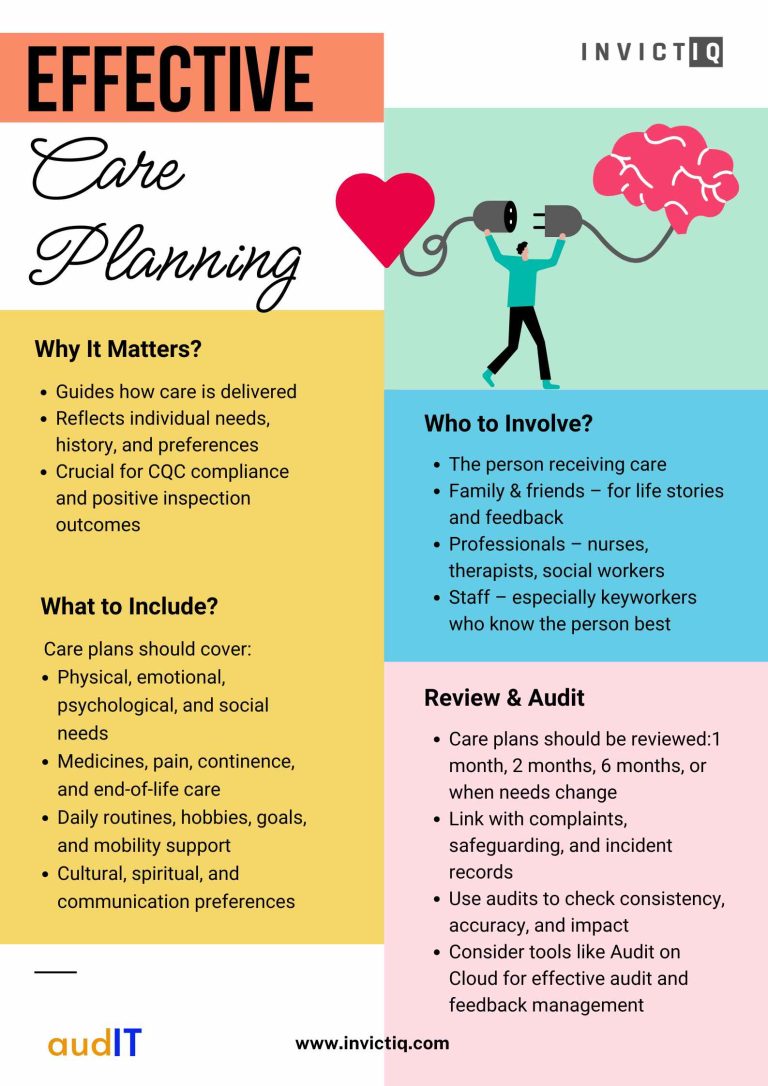@2021 invictIQ is a venture by Sprint Consultancy. All rights reserved. Privacy Policy.

Effective Care Planning in Social Care
by Mark Topps
In the world of social care, care plans are the backbone of the care delivery. There are growing conversations happening about who they are really for, the person being cared for, the staff or the regulator, but for now, they are here and heavily scrutinised. It’s the blueprint for how our staff support individuals, a reflection of their needs, preferences and goals. There is however still a misunderstanding around what to include, how often to review and I thought I would take some time to reflect on what effective care planning looks like, how we ensure it is compliant whilst meaningful and how we can effectively review them
What to include?
I always say a care plan should be detailed so anyone can pick it up and deliver the care to meet someone’s needs. They should be the story of the person and go much further than just their medical needs. It should be like a life story of their past, their current needs and their future ambitions and goals.
The biggest question I am asked is what should be included and NICE has some further reading (www.nice.org.uk/guidance/qs132/chapter/Quality-statement-4-Care-planning) which highlights the standard expected, but they say:
Health and social care plans should be tailored to each person, giving them choice and control and recognising the inter-related nature of multiple long-term conditions. When developing or reviewing a care plan, the person should be offered the opportunity to:
- address a range of needs including medical, psychological, emotional, social, personal, sexual, spiritual and cultural needs, sight, hearing and communication needs and environmental care needs
- address palliative and end-of-life care needs
- identify health problems, including continence needs and chronic pain and skin integrity and the support needed to minimise their impact
- include any requirements for managing medicines, for example, the importance of dosage and timing and the implications of non-adherence
- identify the help they need to look after their own care and support, manage their conditions, take part in preferred activities, hobbies and interests and contact relevant support services
- include leisure and social activities outside and inside the home
- address mobility and transport needs, adaptations to the home and any support needed to use them.
Don’t forget to triangulate your care plan with your risk assessments, mental capacity assessments, deprivation of liberty safeguards etc.
Who to include
One of the most powerful ways to improve your care planning is by involving the person who requires care and support, but also to ask them who else they want involved in their care planning. I have always found the life stories and insights from families vital to developing in-depth, detailed care plans. It is not just at the initial stage of putting this plan together but ongoing. I find relatives are always honest about what they feel is working well, what could be improved and the individual is able to tell you if there have been any changes to their preferences.
Multidisciplinary input is also key so do not forget nurses, therapists, social workers and other professionals who provide care for the people you support. Healthcare professionals all bring valuable perspectives and are also able to access and signpost to other services to help increase independence and meet peoples needs.
Do not forget your staff, especially if you have a keyworker system in place. Your team will know the needs of the people you support more than you and really be able to let you know what should be updated and included.
Auditing and Reviewing
Care plans are not a one term thing, they are a living document that must be reviewed, updated and audited at least once a year, but more frequently if circumstances change. I would personally aim to always do this more frequently as good practice as this will ensure they are as up to date as possible. In the services I have worked in I have done the assessment, put together a care plan and then reviewed this at the 1 month in service mark, 2 months in service and then 6 monthly (or as needs change). One thing I also used to do was triangulate the reviews with any complaints re care delivery, safeguarding concerns and accidents/incidents
Internal audits are a key part of this process as they will help identify gaps, ensure consistency and maintain high standards. Typically, this involves reviewing a sample of care plans, checking for accuracy and ensuring they align with daily records and risk assessments. There are a number of free audit tools available, but I would personally recommend looking for a specialist service such as Audit On Cloud by InvictIQ. It’s built to simplify audits, manage inspections, and capture meaningful feedback—all while supporting high-quality, person-centred care delivery.
The Care Quality Commission (CQC) places significant emphasis on care planning in its inspections. Under the new single assessment framework, inspectors look for evidence that care is planned and delivered in a way that is safe, effective and responsive. They want to see that care plans are up to date, person-centred and regularly reviewed. They also expect to see that people have been actively involved in shaping their own support and this often leads to better inspection outcomes. According to Skills for Care, 83% of services rated “Outstanding” by the CQC cited care planning as a key strength.
Remember, care planning is more than a regulatory requirement. It’s a commitment to meeting people’s needs and ensuring the safety of your staff and the person requiring support
MORE ARTICLES


Mark Topps is a social care leader who has worked in the care industry since 2004 and is currently working as a regional support manager. He regularly advocates, appearing on television, radio and podcasts and has started many campaigns for change in legislation and culture within the industry. Mark is the co-founder of The Caring View which is a social care podcast, YouTube show and free resource initiative for the sector. He also co-founded The Health and Social Care Club, which is an audio event hosted on LinkedIn. Mark is also the social media and marketing director at the National Association of Care and Support Workers.
Sign up for our newsletter
